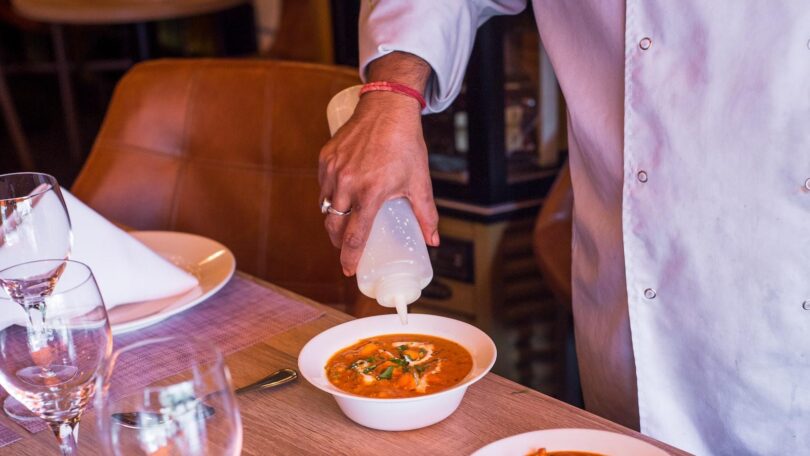Do you ever get a whiff of something that transports you far away from the everyday? Those scents can be found in a variety of places – from beloved comfort foods to those fragrant herbs growing in your garden. Herbs have been a part of traditional cuisine for centuries, and in this article, we explore the wonderful world of culinary herbs – from growing and harvesting to cooking. Read on to learn more!
1. Advantages of Growing Culinary Herbs
Growing Culinary Herbs
- Growing your own herbs gives you access to fresher herbs than store-bought ones.
- You can control the amount of fertilizers and pesticides used in their growth for a healthier plant.
- It’s an economical option to continuously incorporate fresh herbs in your meals.
- Homegrown herbs tend to be stronger and more fragrant than grocery store versions.
- Culinary herbs are easy to grow, making it a great project for beginner gardeners.
- You can experiment with different varieties, colors, and flavors of herbs.
- Planting and harvesting your own herbs is quite rewarding.
Herbs can be grown in your garden, indoors in pots or hydroponically. With patience and proper watering, you can have a thriving herb garden! The most common home-grown herbs include basil, chives, parsley, oregano, rosemary, thyme, cilantro, mint, and sage.
Every herb plant has different requirements for optimal growth. Your ideal growing conditions will vary depending on the variety you grow. Trail and error are the only way to make sure you’re getting the best out of your plants.
You should check your herbs regularly for signs of distress or disease. Additionally, trimming any dead or damaged leaves and stems will promote healthier growth of the plant. Harvest herbs when the plants are most flavorful and vibrant, usually early in the morning.
2. Essential Steps to Plant and Maintain Culinary Herbs
Step 1: Selectectiong your Herbs
When you first decide to plant culinary herbs, you will need to choose which ones to grow. Gather their seeds, or buy starter plants from the store. Basil, thyme, rosemary, and oregano are just a few of the staples that are easy to find and cultivate. Keep in mind which flavors you prefer and the type of cooking you will be using the herbs for.
Step 2: Planting
Once you’ve picked out your favorites, you’ll need to decide how to plant them. Some culinary herbs, such as parsley, prefer to be started indoors first and then transplanted to a garden outdoors when large enough. Others, like oregano, can simply be planted directly outside. Depending on herb and climate, you can either plant your herbs in a row in your garden or make dedicated containers for each one.
Step 3: Care and Maintenance
Once your herbs have been planted, regular pruning and watering will be necessary to ensure that they are getting all the nutrients they need to grow. Don’t forget to fertilize regularly, if you choose to do so. Monitoring soil pH levels can also be beneficial. Keep in mind that some herbs grow best in direct sun, while others prefer partial shade.
Step 4: Harvesting
When harvesting herbs, it is best to wait until the plants are mature before taking leaves off them as it helps encourage new growth. At this stage, the leaves will have the strongest flavor, so wait until the plants have reached their full potential before snipping off leaves. You can either harvest by cutting leaves from the stem or by pinching them off between your fingers.
Step 5: Storage
Once you have finished harvesting your herbs, you’ll need to store them properly to retain their flavor and shelf life. Fresh herbs can be stored in the crisper of your refrigerator or a cool, dark place. They can also be dried, frozen, or used immediately. Before using in cooking, make sure to rinse and dry any herbs you have collected.
3. Harvesting Culinary Herbs – Timing is Everything
Harvesting Culinary Herbs – Timing is Everything
- Harvesting culinary herbs is an incredibly important step in the growing process.
- The size, flavor, and texture of the herbs can depend greatly on when the herbs are harvested.
The key is to pick herbs before they go to seed, which is especially important for annual herbs. Annual herbs are herbs such as basil, oregano, and cilantro. These herbs will begin to flower when they reach maturity, which can significantly change their flavor. Ideally, you should pick these herbs as soon as the true leaves are fully developed. Picking them at this stage will allow you to use them at their peak flavor.
Perennial herbs, on the other hand, should be harvested as late as possible so they can store energy. These herbs include rosemary, thyme, and lavender. To ensure the best flavor, only harvest the top few inches of growth. This will not only prevent the plant from going to seed, but also ensure that the rest of the plant remains healthy and vigorous.
When harvesting, it’s best to use scissors instead of pulling the stems off the plant. This will leave the plants looking more natural and help keep pests and diseases away. It’s also important to use clean, sharp scissors to prevent contamination.
In general, when harvesting, make sure to take only a few branches or stalks at a time. This will help keep the plant from wilting or dying off. After harvesting, make sure to spread out the herbs in a single layer so they can dry properly. When the herbs are dry, you can store them in an airtight container and use them over the next few months.
Harvesting the herbs at just the right time can make all the difference when it comes to taste. By following the tips mentioned above, you can make sure you’re harvesting and using culinary herbs at their peak flavor.
4. Preserving Herbs For Future Use
The bounty of fresh herbs growing in your garden is a wonderful opportunity to enjoy delicious and nutritious dishes. Here are a few tips for making sure you can make the most of your herbs when cooking:
- Harvesting: Harvest herbs early in the morning, when possible, as this is when their flavor is at its peak. Trim individual leaves or stems as needed, but be sure not to take too much—if you can, harvest no more than one-third of each plant to allow it time to recover.
- Storage: Once harvested, store herbs in the refrigerator or a cool, dark place in paper bags or sealed containers. For long-term storage, dry herbs or freeze them in ice cubes with a little water.
For those looking to enjoy their herbs no matter the season, preserving and storing herbs can be an easy and efficient way to do so. Here are some tips for successfully preserving each type of herb:
- Parsley: Chop the parsley in a food processor until it reaches the desired fineness. Transfer to an airtight container and store in the refrigerator.
- Basil: Wash and cut off the ends of the basil leaves. Set aside on towel and allow to air dry. Once dry, layer the leaves between parchment paper and store in an airtight container.
- Rosemary: Fill a small jar with enough olive oil to cover all of the rosemary sprigs. Place in a refrigerator and allow to steep for 1-2 weeks. The oil can then be strained and used to enhance a variety of dishes.
Preserving herbs is easy and will allow you to cook with them all year round. With these simple tips, you can enjoy fresh, nutritious, and delicious dishes with fresh herbs even when it’s not harvest season!
5. Cooking with Culinary Herbs – Creative Ideas and Tips
When it comes to spicing up regular dishes, herbs are often the go-to ingredient. Not only do they add flavor and color, but their health benefits can be invaluable. There are few things to consider when looking into growing, harvesting, and cooking with herbs.
-
Choose the Right Herbs: Choose between perennial and annual herbs when determining which herbs will fit in with the existing kitchen palette. The flavors that each type of herb offers will differ, so it is important to think about which herbs work best with dishes since they will add different layers of flavor.
-
Growing Herbs: Proper soil, adequate drainage, and the best environment for the herb to grow well are some of the considerations to think about before planting. It is also important to note which herbs do best in containers or the garden, along with understanding herb dormancy and plant care.
- Plant Care: To ensure that herbs don’t overcrowd or get too large, it is important to thin them out every couple of weeks. Trim and prune herbs when necessary as well.
- Harvesting: The best time to harvest is right before the herb blooms, as herbs tend to become bitter and lose flavor post-bloom. Cut the stem of the herb about a few inches above the ground and make sure to harvest as much of the plant as possible.
- Preserving Herbs: There are a variety of ways to save and preserve herbs, from making herb-infused oils, vinegars, and teas to drying and freezing herbs. Choose the best preservation technique based on how many times herbs will be used and the length of time they need to remain preserved.
- Cooking with Herbs: Different herbs are best used in distinct dishes. Do a bit of research into what type of dish works best with certain types of herbs in order to get the most zest and flavor out of them. If adding herbs to a dish, it is best to cook them for around 40 minutes or less. Adding small amounts of herbs at the beginning of the cooking process and adding larger amounts toward the end can help balance flavors.
These tips should provide a foundation of understanding on what it takes to grow and cook with herbs. It is important to follow tips and do research in order to find the best way to use culinary herbs that can bring out the most flavor and add freshness to dishes.
6. Making the Most of Herbal Remedies
Harvesting Herbs for Culinary Purposes
- Harvesting herbs for culinary purposes requires an understanding of the right time of day to harvest—early morning, when the essential oils are at their fullest.
- The best way to harvest is to cut individual stems, starting at the bottom of the plant. The top of the plant should also be harvested to promote bushiness.
- When harvesting herbs, leave enough of the plant to survive and continue growing. Harvest sparingly, small amounts at a time, rather than stripping the plant of all the leaves.
Preserving Herbs for Later Culinary Use
- Herbs can be preserved by drying or freezing: the choice will depend on the requirements of the dish you’d like to make.
- Dried herbs tend to have a stronger flavor and should be used in cooked dishes, while frozen herbs work best in uncooked dishes.
- The best way is to dry the herbs is to cut and spread them on a sheet of paper in the sun: the heat causes the water to evaporate and the herbs are preserved.
- Alternatively, you can freeze the fresh herbs by cutting and washing them before freezing in an airtight bag.
Using Herbs in Cooking
- Herbs can be used in a variety of ways: as ingredients in salads, stews, stir-fry dishes, and more.
- Herbs can also be used to season any dish: adding them at the start will infuse the flavor throughout the dish, while adding them at the end will give the dish a stronger herb flavor.
- When adding herbs to a dish, it’s important to remember that dried herbs are more potent than fresh ones, so a little goes a long way.
- Depending on the dish you are making, it can be beneficial to use a combination of both fresh and dried herbs to achieve the desired flavor.
- Herbal remedies can provide a natural and cost-effective way to treat a variety of ailments.
- They can be used to treat everything from stomach aches and headaches to infections.
- Herbal remedies are easy to make at home and can be taken as teas, tinctures, capsules, or ointments.
- It is important to be aware of potential side effects and interactions with medications, as herbal remedies can be unpredictable.
- Before taking any type of herbal remedy, it is important to consult with a qualified healthcare provider to ensure safety and effectiveness.
7. Conclusion – Culinary Herbs: A Versatile Garden Gem
Herbs are versatile and can be used in a variety of dishes. They can add an extra level of flavor to many dishes. Growing, harvesting, and using herbs in cooking are all fun and rewarding activities that can help you reap great rewards in the kitchen. When growing herbs, look for sunny spots where you can plant them in well-drained soil. To harvest, pull or cut the plant’s branches. Then, either store, dry, and grind the herbs to use later or use them fresh. To use fresh herbs, choose the leaves and/or flowers that look the best and have the strongest aroma. To get the best flavor, it is important to add the herbs near the end of cooking.
- Selecting the Right Herbs: Choose herbs that work well with the food you’re cooking. Certain herbs, such as sage and rosemary, are better used as dry ingredients. Others, such as basil, are best used fresh.
- Quality Matters: Always get the freshest, best-quality herbs so you can get the best flavor.
- Balancing the Flavor: Be careful not to overpower a dish with too much herb flavor. Start with a small amount and add more as needed.
- Storing Herbs: Store herbs in an airtight container in a cool, dark place. You should also store any dried herbs in an air-tight container.
With a little care and practice, you can reap the rewards of having a garden full of delicious, aromatic herbs. By learning how to properly care for them, harvest them, and use them in cooking, you’ll find that herbs are an invaluable addition to any kitchen. To conclude, the growing and harvesting of culinary herbs is a rewarding experience that can bring a world of flavor and fragrance into your cooking! With the right knowledge, ingredients, and techniques, you’re well on your way to becoming an herb-growing, harvesting, and cooking master!








